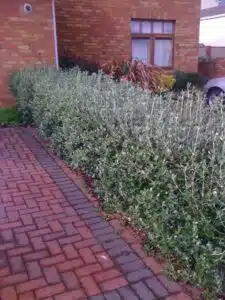*HALF PRICE BLACK FRIDAY SALE ON NOW*
ORDER ONLINE OR CALL OUR FRIENDLY TEAM ON 01580 765600
Menu
*HALF PRICE BLACK FRIDAY SALE ON NOW*
ORDER ONLINE OR CALL OUR FRIENDLY TEAM ON 01580 765600
 https://www.hopesgrovenurseries.co.uk/wp-content/uploads/2024/02/DSC01948-1-750x563.jpg
HEDGES FOR COASTAL GARDENS
https://www.hopesgrovenurseries.co.uk/wp-content/uploads/2024/02/DSC01948-1-750x563.jpg
HEDGES FOR COASTAL GARDENS
If you garden close to the coast, your plot will almost certainly be exposed to salt-laden winds at times. The western coasts are warmer and wetter than the Eastern side of the UK, which is drier and colder. Many plants struggle close to the coast, but it’s not all bad news. The close presence of a temperate sea will provide you with more-ambient temperatures, so you’re likely to avoid extremes. Bitterly cold spells are likely to be brief affairs and high summer temperatures don’t rise to the dizzy heights inland areas may experience.
The temperate climate is a double-edged sword, because many hardy plants produce their own version of antifreeze once temperatures begin to fall. This defence mechanism, which is prompted by colder weather, makes plants hardier. Problems occur when the temperatures stay unusually mild, because the plant is not prepared for colder conditions. When temperatures suddenly plummet, as they did at the beginning of this year (2023), plants haven’t produced their version of antifreeze. The risk of dying is greater than it would be during a traditional winter. It’s rather like sudden-shock syndrome. Many of us lost established plants last year- for this reason.
 Luckily, certain plants are adapted to coastal conditions. They include the daisy bush, Olearia macrodonta, a reliable and rugged hedging plant. This New Zealander needs a warm, well-drained position but that shouldn’t be a problem. Most coastal soils tend to be light and friable. You’ll get domes of creamy-white daisies in July and August and these emit a pleasant, slightly musky fragrance. The flowers are very popular with bees and butterflies. The sage-green leaves resemble silver-dusted holly and one of the common names is New Zealand holly. When the wind blows, the leaves flutter and display their silvery undersides, so this forms a soft, cloud-like hedge up to six feet tall, or 2m. Should it suffer following a bad winter, cut it back in mid-April to rejuvenate it. The daisy bush is also good on chalk and you can also tuck it into a sheltered nook in colder areas, although it wouldn’t make a hedge in colder parts of the country.
Luckily, certain plants are adapted to coastal conditions. They include the daisy bush, Olearia macrodonta, a reliable and rugged hedging plant. This New Zealander needs a warm, well-drained position but that shouldn’t be a problem. Most coastal soils tend to be light and friable. You’ll get domes of creamy-white daisies in July and August and these emit a pleasant, slightly musky fragrance. The flowers are very popular with bees and butterflies. The sage-green leaves resemble silver-dusted holly and one of the common names is New Zealand holly. When the wind blows, the leaves flutter and display their silvery undersides, so this forms a soft, cloud-like hedge up to six feet tall, or 2m. Should it suffer following a bad winter, cut it back in mid-April to rejuvenate it. The daisy bush is also good on chalk and you can also tuck it into a sheltered nook in colder areas, although it wouldn’t make a hedge in colder parts of the country.
If you want a lower, denser hedge, opt a hardier naturally occurring hybrid found on New Zealand’s South Island – Olearia x hastii. This hybrid between O. avicenniifolia and O. moschata, has oval, darker green foliage that’s felted in white on the underside. Many New Zealand plants have adapted to deter grazing animals and Olearia x hastii is no exception. It’s on the RHS list of rabbit-proof plants – should you have a problem. All daisy bushes need sympathetic pruning, straight after the first flush, to encourage the flowers.
Choisya, or Mexican orange blossom, does well on the coast in sunny positions on well-drained soil. It doesn’t like having et roots This evergreen is best grown as informal hedge, because you’ll lose the white summer and autumn flowers if you tightly clip it. Prune lightly in late autumn, after the flowers have finished, to keep the shape.

There are three orange-blossom options. Choisya ternata forms a large glossy green roundel and, when planted as a hedge it will billow out and reach up to 10ft in height and width, so it needs space. The foliage has three fingers, hence the name ternata, and the leaves are aromatic when crushed. They’re reminiscent of basil. The white starry flowers are sweetly scented you’ll get more flower in sunnier positions. ‘Sundance’ is a golden-leafed form and it stays far brighter when grown in a sunny, open position. The new growth is a striking limey yellow, but the colour dims in shadier positions.
‘Aztec Pearl’ is a more-compact Choisya with more-finely divided foliage. It forms a four-to-five-foot roundel and should make a shoulder-high hedge. ‘Aztec Pearl’ flowers earlier in the year, producing a prolific flush of large white flowers in May. These flowers emerge from pink buds, so there’s an apple-blossom softness about this one. There’s a second minor flush of flower in early autumn.
‘Aztec Pearl’ was raised by hybridiser Peter Moore, in the days when he worked for Hilliers and it was launched in 1989. This complex cross between C. dumosa var. arizonica and C. ternata has become one of Europe’s top selling shrubs. Peter advises people to trim it after the first flush of flower is over. In recent years he’s bred buddleias too and he formed the Plant Heritage collection at Longstock Park nursery, near Stockbridge in Hampshire. Peter Moore has his own website – www.bredbypetermoore.co.uk
Peter has also worked on Aucuba japonica, a low-growing Japanese evergreen that’s under-appreciated in this country. His compact ‘Golden Girl’ has large red berries and mottled foliage that’s more mayo than green. This small shrub is a long-lived toughie and most are capable of thriving in many different conditions. Aucubas tolerate poor soil, pollution, deep shade and damp soil too, although they don’t do well on chalk. This shrub is heavily used by landscapers and ubiquitous in car parks and supermarkets. The most commonly grown forms have oval leathery leaves finely spotted in yellow. The foliage illuminates shady positions, particularly in winter. They are most useful in very shady areas close to buildings.
Hedges reach roughly four-feet in height, on average, and they should be trimmed back in early autumn, before cold weather sets in. Female forms, such as ‘Variegata’, produce large red berries as long as there’s a male plant nearby. This variegated aucuba was the first to be introduced from Japan, in 1783. Aucubas are slow-growing shrubs, putting on an average of nine inches (25cm) per year.
They were Victorian favourites and they were widely used at Brodsworth Hall near Doncaster, now owned by English Heritage. This Italianate house and garden were created between 1861 and 1863, by Charles Thellusson. He was born in Florence in 1822, but spent his childhood in fashionable Brighton. Thellusson was well-known in the mid 19th century, because he was heir to a famously disputed fortune. There was a very public battle in the High Court that lasted for almost 60 years. The case, which used up much of his inheritance, inspired Charles Dickens to write about Jarndyce versus Jarndyce in Bleak House.
Brodsworth Hal, close the coal fields of Doncaster, fell into disrepair and was acquired by English Heritage in 1988. The garden underwent a sensitive restoration during the 1990s. The original hollies, yews and aucubas were rejuvenated by radical pruning. Then they were clipped and topiarised and the garden, which has a large fern collection, is a glorious sight in winter. The gardeners use variegation wisely and surround it with plenty of green-leafed plants. Variegation needs careful handling, otherwise it will bilious.

Laurustinus, or Viburnum tinus, is another Victorian favourite suited to coastal regions. This demure evergreen flowers in winter, producing heads of pale flowers encased by pink buds. Although unscented, this dainty evergreen will perform in dank, dark spaces. It can be cut back by the weather in hard winters, because (like most evergreens) isn’t as hardy as deciduous shrubs are. This Mediterranean shrub has been grown in Britain since the late 16th century. ‘Eve Price’ is a prettier more-compact option with carmine buds and pink-tinged flowers. The flowers begin in November and carry on until May, so you get months of interest and you don’t have to be by the seaside to grow this one.
Pleached trees are a garden-design favourite, because they provide an instant leafy screen that looks stylish as soon as it’s planted. They offer privacy for you and they help to muffle noise and that’s becoming more important in our busy world. They provide a living screen that’s far more eco-friendly than a stark wooden fence…
Green is such an important colour in the garden. In winter it provides warmth and reassurance, like a beating heart ticking away while the rest of the garden slumbers. In summer, it’s the complete opposite. Rich-green cools and soothes the garden and the gardener alike, acting as a backdrop or shade caster. The rich foliage…
Gardeners are nurturers by nature: it goes with the job description! We care for plants and, hopefully, they grow for us. We’re also in tune with nature, simply because we’re outside an awful lot. When we’re looking at our plants, we notice the spiders, the bees and the butterflies. They are the living layer: the…